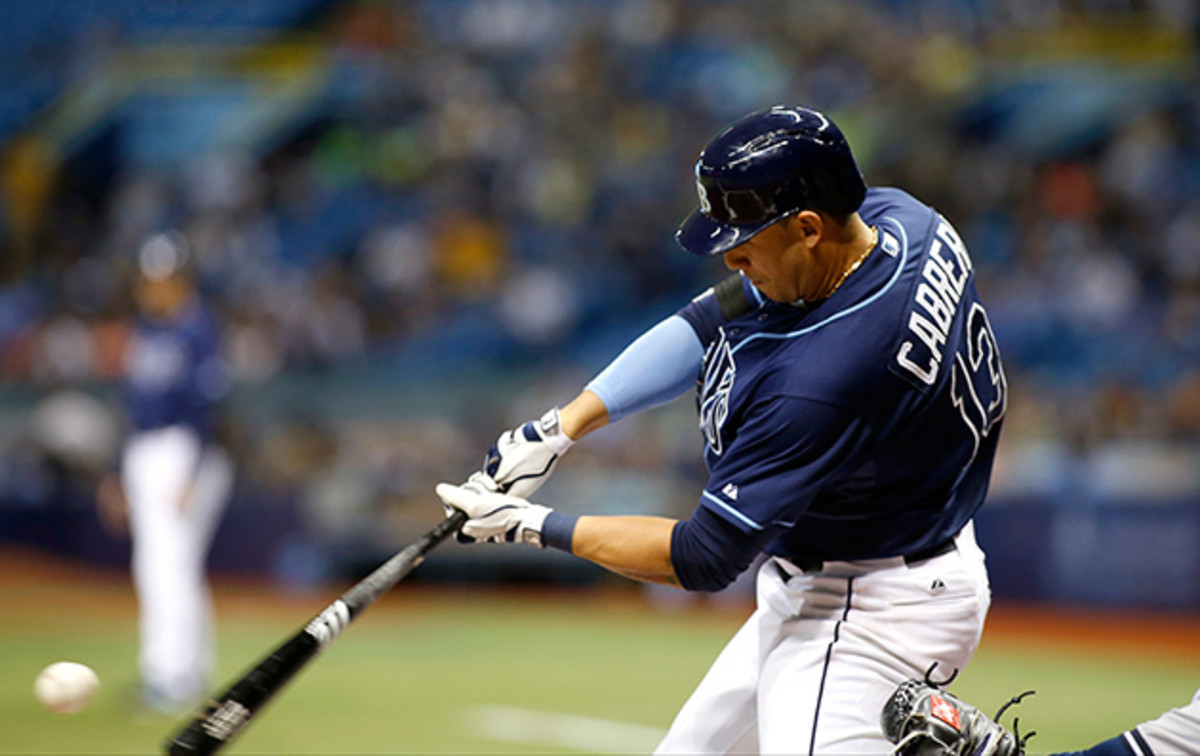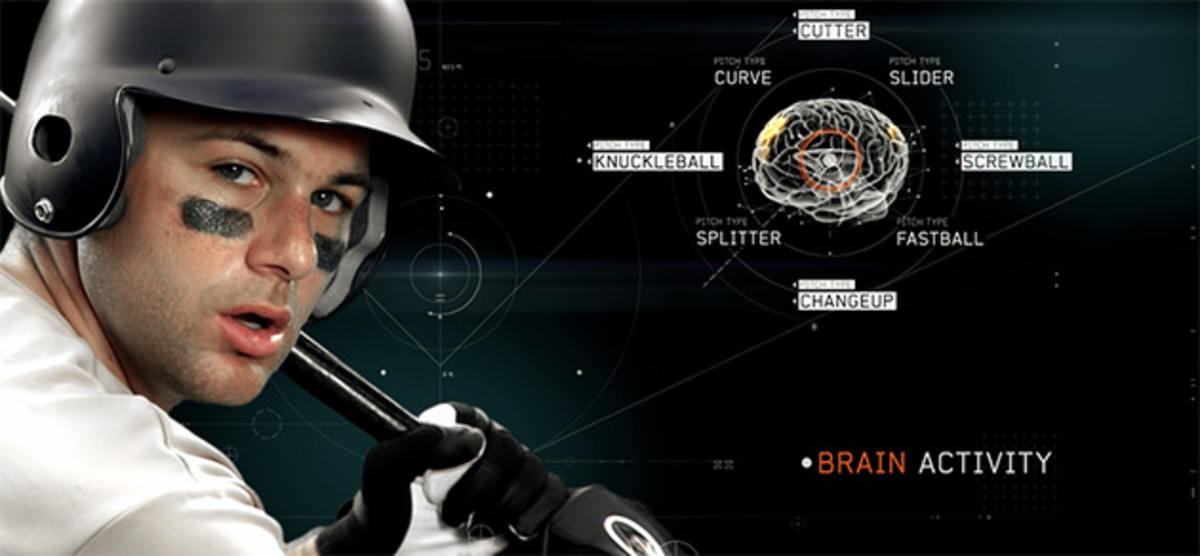Seeing the benefit: MLB teams focus on enhancing players' visual training

This story appears in the April 13, 2015, issue of Sports Illustrated. Subscribe to the magazine here.
Not long after the Rays first asked him to play the video game in 2013, shortstop Cole Figueroa became focused on winning it. The idea was to identify as early as possible whether the seams were visible on a spinning baseball, and to hit a laptop key if they were. He was careful to play in controlled environments and to minimize distraction, and he was consistently at the top of the organizational leaderboard, but that wasn’t enough.
So Figueroa, who knows two programming languages, figured out how to cheat: He camped above the space bar, hitting it every time a ball appeared on-screen, seams or no. He was wrong about half the time, but the points he gained from quick reactions outweighed the points lost. “I’m really competitive,” he says. When the next update of the program, called Neuroscouting, came out about a month later, the designers had added code to prevent guessing. “They were like, We get what you’re doing and we don’t like it,” Figueroa, now a Yankees minor leaguer, says with a laugh.
He was probably right to try to get himself ranked as high as possible. Teams across baseball are working with companies like Neuroscouting to introduce vision and reaction-time programs into their evaluation and training processes. Ophthalmology in MLB has evolved: Teams who once shunned prospects who wore glasses now use EEGs to track what hitters see and when.
Science of nap time: Seeking an edge in the most basic of all human needs
“Hitters have three tenths of a second on a 90 mph pitch to make a decision,” says Keith Smithson, the Nationals’ team optometrist. “If we can buy a tenth in there somewhere, we gain the ability to foul it off if we were gonna miss it or put it in play if we were gonna foul it off.”
Smithson uses a three-tiered approach to eye care: He tests and corrects visual acuity (the average major leaguer has 20–121⁄2 vision, and he’ll prescribe lenses for anyone at or above 20–20); trains the seven muscles around the eye to focus through drills, both high and low tech; and tries to improve visual processing, the communication between the eyes and the brain.
“It used to be that we had the science but technology hadn’t caught up,” says Smithson. “Now we’re starting to have the technology too.”
Yankees outfielder Carlos Beltran famously loved the ocular-enhancer machine—a device that shoots numbered and colored tennis balls at up to 150 mph while hitters try to identify them—so much that he wrote it into his 2005 contract with the Mets. That machine is still in use around baseball, as is one of its descendants, a light track, which is like a landing strip that simulates pitches at varying velocities and timings. Hitters stand 10 feet away, beneath an infrared sensor, and try to swing at the correct moment.

That’s one of the benefits of vision training—unlike with a lifting program, where an athlete might see a result only after several weeks of training, the difference can show up after 15 minutes of ocular workouts, so it’s easy to get players to buy in. As often as possible, Smithson tries to incorporate vision training into other exercises so it doesn’t even take up extra time. Players wear strobe glasses that blink cloudy and clear while sprinting or catch wiffle balls at random while doing squats.
Those drills and computer programs like the Vizual Edge, a web-based platform that helps improve efficiency of eye movement through a series of games, some requiring the use of 3D glasses which the Nats’ Denard Span likes so much he has an individual subscription, help improve the focus of the eye and are important, but the biggest advances recently have come from visual processing, such as the game Figueroa played.
Neuroscouting is one of several companies offering increasingly advanced programs that test and train athletes’ decision-making processes. One, deCervo, whose founder has worked with the military to hone soldiers’ responses to auditory stimuli, uses electrodes to take EEGs in real time as players go through the games.
Enter the Cryosauna, the new-age training device of Floyd Mayweather
One of the next frontiers may be the use of vision training in injury prevention, especially among pitchers. Even in the Nationals organization, one of the most eye-focused in baseball—Washington has a separate training room for ocular work—only about half as many pitchers as position players train regularly, but that tenth of a second that allowed a hitter to foul off a ball could allow a pitcher to get his glove up in time to protect his jaw from a comebacker.
In the case of Rays outfielder Steven Souza, a devoted vision trainer from his years with the Nationals, the safety aspect isn’t theoretical. Early in spring training, he was standing on a field during batting practice when non-roster outfielder Corey Brown yelled to him to watch out. Without thinking, Souza turned and caught a line drive a fraction of a second before it slammed into his face. He considers himself basically accident-proof.
“I may have a bruise on my hand,” he says, “but I’ll be all right.”
It’s even come in handy after injuries—Rays DH John Jaso was prescribed a vision-training program called Home Therapy System as he tried to return from postconcussion syndrome and still plays it occasionally to keep himself sharp.
“At first it’s a totally helpless feeling,” he says of playing the game, but once he’s on the field, “all of sudden it’s like, 'Whoa! There’s a ball!' and your eyes can focus in on it.”

Sixty-five percent of the brain is devoted to the ocular system, explains Micky Collins, who is the director of the University of Pittsburgh’s concussion program and treated Jaso, so up to 35% of concussion sufferers can have some amount of eye dysfunction.
He’s hesitant to suggest that vision training can preventatively reduce the risk of concussion, but a deficiency at the muscular or visual processing levels can be a risk factor for a difficult recovery if head trauma is sustained.
“It takes less force to cause an injury in someone whose systems aren’t working,” he says.
And there’s evidence that vision training while rehabbing can help players return even from physical injuries faster, because robbing them of visual information through the use of strobe glasses and similar exercises forces them to be conscientious with the rest of their activities.
But of course, not everything has a scientific basis. Some players use a Japanese brand of eye drops that has no effect other than to make their eyes sting, feeling it wakes them up.
“It’s been around for as long as I’ve been around,” says Smithson. “Some of it, you just do because you do. As long as they believe it, as long as they’re not getting hurt, we let them keep doing it.”
